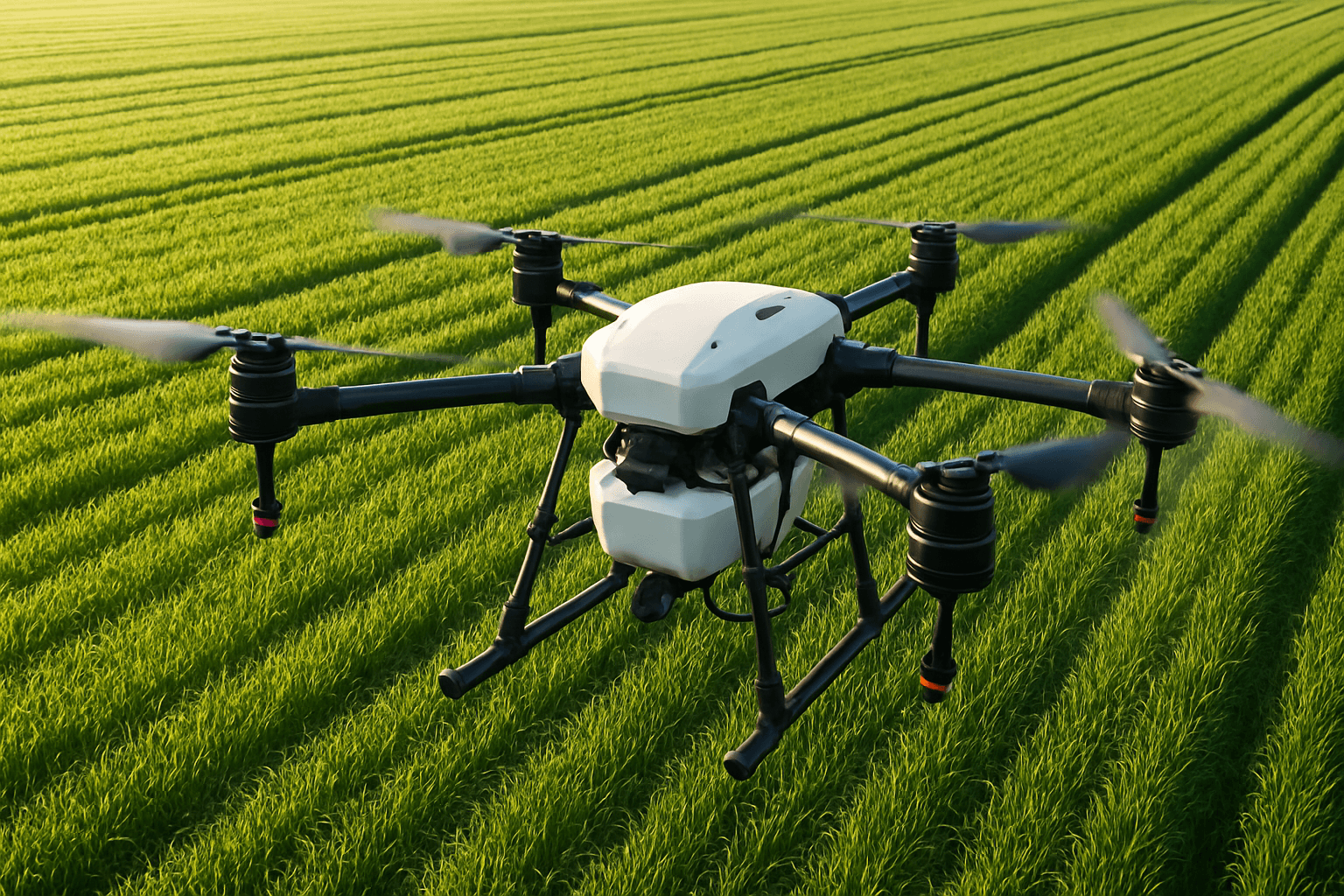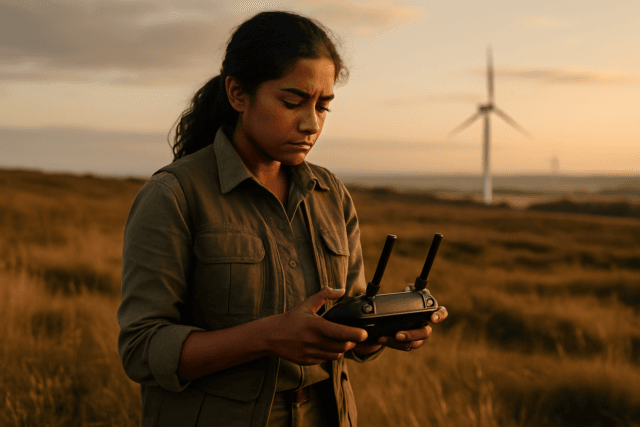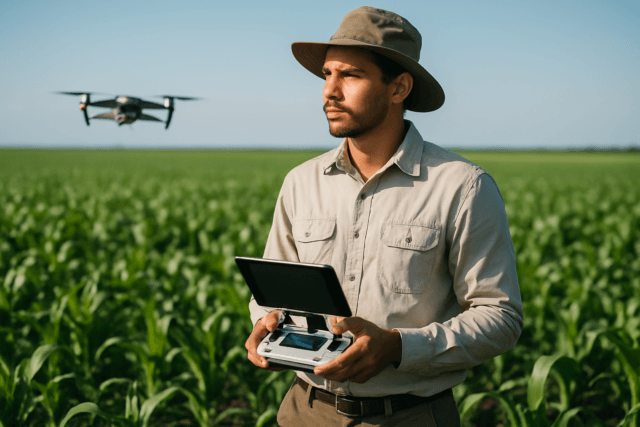Drones are rapidly changing the landscape of agriculture, providing farmers with unprecedented insights and capabilities to optimize their operations. From crop monitoring to precision spraying and planting, these unmanned aerial vehicles (UAVs) are becoming essential tools for modern farming. The agricultural drone market is experiencing a boom, projected to reach $18.22 billion by 2030. Let’s explore the diverse applications of drone technology in agriculture and how they can revolutionize farming practices.
What are Agriculture Drones?
Agricultural drones, also known as farming drones or UAVs, are specialized aircraft equipped with sensors, cameras, and data collection tools designed for use in farming and agricultural applications. These drones range in size and capabilities, from small quadcopters to larger fixed-wing aircraft. They provide valuable data for precision agriculture by monitoring crops, livestock, and land.
Key Applications of Drones in Agriculture
Drones are used across a wide spectrum of agricultural activities, offering solutions to improve efficiency, reduce costs, and promote sustainable practices. Here’s a detailed look at their primary applications:
1. Crop Monitoring and Health Assessment
- Real-time data: Drones equipped with high-resolution cameras and advanced sensors like multispectral, hyperspectral, and thermal imagers provide real-time data on crop health and growth patterns.
- Early disease detection: Drone-based imaging can detect diseases and nutrient deficiencies early, boosting crop yields by up to 25%.
- NDVI technology: Drones use Normalized Difference Vegetation Index (NDVI) to assess plant health by analyzing detailed color information.
- Biomass estimation: Drones can estimate plant biomass and growth rates, helping farmers optimize resource allocation.
2. Precision Spraying
- Targeted application: Drones can precisely apply pesticides, herbicides, and fertilizers only where needed, reducing chemical usage by up to 35%.
- Reduced runoff: Targeted spraying minimizes chemical runoff and environmental exposure.
- Hard-to-reach areas: Drones can navigate difficult terrains like steep tea fields, making spraying in these areas more efficient and safer.
- Cost-effectiveness: Drone spraying can be more cost-effective than traditional methods, especially for small, irregular-shaped fields.
3. Planting and Seeding
- Automated seeding: Drones can automate the planting of seeds, particularly in forestry and hard-to-reach areas.
- Efficiency: Drone seeders can plant much more efficiently than manual methods, with teams capable of planting hundreds of thousands of trees per day.
4. Field Mapping and Surveying
- Detailed mapping: Drones create accurate field maps, including elevation information, to identify irregularities in the field.
- Drainage analysis: Elevation data helps determine drainage patterns and identify wet/dry spots for more efficient watering techniques.
- Soil analysis: Drones can collect soil samples and provide insights into soil fertility, pH levels, and moisture content.
5. Irrigation Monitoring
- Moisture detection: Drones equipped with thermal cameras can detect both dry and wet ground, allowing farmers to adjust irrigation as needed.
- Water stress identification: Thermal imaging can identify areas of water stress in crops, enabling targeted irrigation.
6. Livestock Management
- Livestock tracking: Drones can monitor livestock movement and help count animals, improving management efficiency.
- Remote oversight: Drones equipped with cameras allow for remote monitoring of livestock without the need to physically traverse the land.
- Locating lost animals: Drones can quickly locate lost or sick animals, ensuring the herd is where it should be.
7. Security
- Farm monitoring: Drones can monitor the far reaches of a farm, saving time and enabling more frequent monitoring of hard-to-reach areas.
- Equipment oversight: Drone cameras provide an overview of farm operations, ensuring everything runs smoothly and locating equipment.
- Perimeter security: Drones can monitor fencing and perimeters, especially for valuable crops like cannabis, reducing the need for security personnel.
8. Yield Prediction
- Data-driven insights: Drones provide high-level data about yield, allowing farmers to predict yield for future seasons.
- Optimization: By integrating drone data with machine learning models, farmers can optimize fertilizer use, irrigation schedules, and pest management to improve yields.
9. Weed and Pest Control
- Weed detection: Aerial photography can identify weed infestations for targeted removal.
- Pest management: Drones with specialized cameras and sensors can detect specific weeds and pests, enabling more precise control strategies.
- Reduced herbicide use: Precision agriculture drones enable more precise weed strategy planning, reducing herbicide growth.
10. Flood Risk Assessment
- High-resolution data: Drones can provide higher resolution data for flood risk models and water resource management.
11. Scouting and Damage Assessment
- Rapid assessment: Drones can quickly scout fields for disease outbreaks, growth irregularities, or other issues.
- Damage evaluation: High-resolution aerial views allow farmers to zoom in on areas of interest to identify and GPS-tag issues like weed populations, pest damage, and weather damage.
Benefits of Using Drones in Agriculture
The adoption of drone technology in agriculture brings numerous benefits, enhancing efficiency, sustainability, and profitability.
Increased Efficiency and Productivity
- Time-saving: Drones can cover up to 500 acres of farmland in a single day, a task that would take weeks using traditional methods.
- Faster data collection: Drones efficiently collect large amounts of data, guiding better decision-making.
- Reduced labor costs: By automating tasks and providing detailed insights, drones reduce the need for manual labor.
Cost Savings
- Reduced input costs: Precision spraying and fertilization reduce the waste of chemicals and fertilizers.
- Optimized resource use: Data analytics from drones can reduce fertilizer and pesticide use by up to 30%, cutting operational expenses.
- Extended asset lifespan: Drones enable proactive maintenance and monitoring, extending the lifespan of expensive assets.
Improved Decision-Making
- Real-time insights: Drones provide real-time data and monitoring, enabling farmers to make informed decisions about crop management.
- Data-driven farming: Drones capture detailed data on crop conditions, allowing farmers to make informed decisions about irrigation, fertilization, and pest control.
Enhanced Sustainability
- Reduced chemical use: Targeted application of inputs minimizes the environmental impact of farming.
- Water conservation: Drones help optimize irrigation, conserving water resources.
- Soil health: Precision crop management helps preserve soil health and water quality.
Improved Safety
- Reduced applicator risk: Drones reduce the risk of applicators being contaminated by pesticides, especially those using backpack sprayers.
- Access to hazardous areas: Drones can access hazardous or hard-to-reach areas, reducing the need for human intervention in dangerous situations.
Challenges and Considerations
While drones offer significant advantages, there are also challenges and considerations to keep in mind when adopting this technology.
Regulatory Compliance
- Regulations: Farmers must comply with local and national regulations regarding drone operation, including licensing and airspace restrictions.
- Staying informed: Keeping up-to-date with changing regulations is crucial for legal and safe drone use.
Initial Investment
- Cost: The initial investment in drones, sensors, and software can be significant.
- ROI analysis: Farmers should carefully analyze the return on investment (ROI) to ensure the benefits outweigh the costs.
Data Management and Analysis
- Data overload: Drones generate vast amounts of data that can be overwhelming to process and analyze.
- Software and expertise: Farmers need specialized software and expertise to turn drone data into actionable insights.
Weather Dependency
- Weather limitations: Drone operation can be limited by weather conditions such as strong winds, rain, and fog.
- Operational planning: Farmers need to plan drone missions carefully, considering weather forecasts and potential disruptions.
Top Drone Models for Agriculture
Selecting the right drone for agricultural applications depends on farm size, budget, and data collection needs. Here are some of the top drone models available:
- DJI Agras Series: Ideal for spraying and seeding, with models like the Agras T50 offering high payload capacity and efficient spraying systems.
- DJI Mavic 3 Multispectral: Best for precision crop monitoring, combining an RGB camera with a multispectral camera for detailed imagery across various wavelengths.
- DJI Matrice 350 RTK: Excellent for industrial crop monitoring, offering robust build, weather resistance, and long flight times.
- AgEagle eBee X: A top choice for industrial-scale operations, providing excellent precision mapping and detailed crop health assessments.
- Parrot Bluegrass Fields: A cost-effective solution offering great value for crop monitoring.
Software Solutions for Agriculture Drones
Effective data processing and crop management require specialized software solutions. Some of the top options include:
- Pix4Dfields: Offers precise map generation and yield prediction tools.
- DJI Terra Ag: Integrates seamlessly with DJI drones for comprehensive data processing.
- Aeroview by Aerobotics: Provides advanced analytics for crop health and management.
- Solvi: Enhances field analysis with detailed soil and crop data.
- Cloverfield by Hiphen: Delivers robust mapping and variable rate application planning.
The Future of Drones in Agriculture
The future of drone technology in agriculture is promising, with ongoing advancements and increasing adoption.
- AI integration: The integration of artificial intelligence (AI) is enhancing drone capabilities, enabling real-time crop insights, predictive analysis, and automated tasks.
- Swarm technology: The development of drone fleets that can tackle agricultural monitoring and other tasks collectively is on the horizon.
- Automated services: Automated disease detection, spraying, and on-farm housed drones are expected to become feasible services in the coming years.
Conclusion
Drones are revolutionizing agriculture by providing farmers with tools to enhance crop management, optimize resource use, and improve overall sustainability. As technology advances and regulations evolve, drones will continue to play a key role in shaping the future of farming, helping to feed a growing global population while minimizing environmental impact. By embracing drone technology, farmers can unlock new levels of efficiency, precision, and profitability, ensuring a more sustainable and productive future for agriculture.





